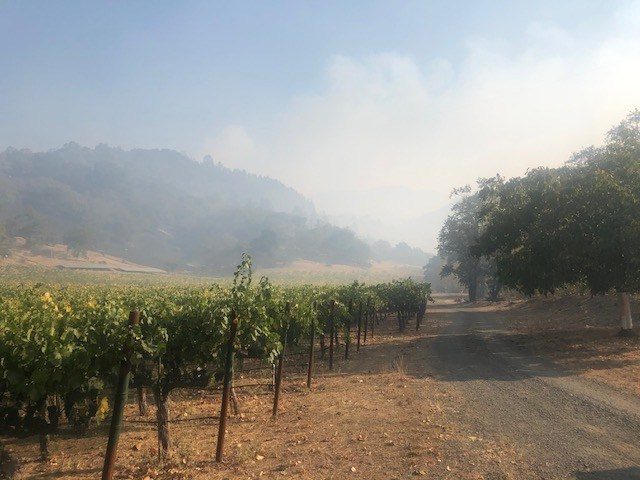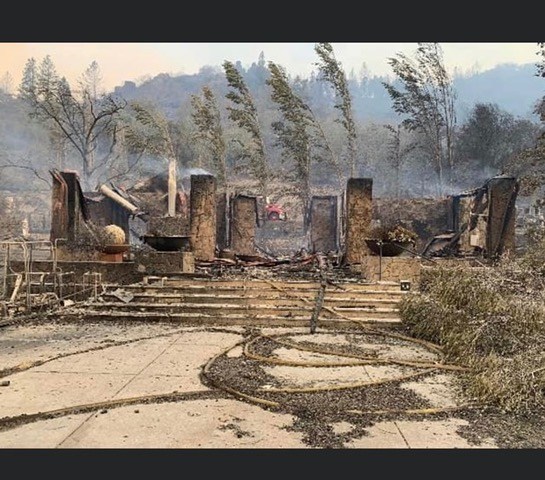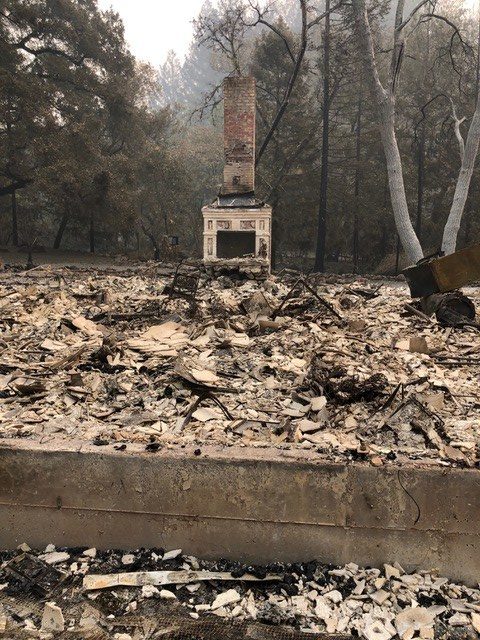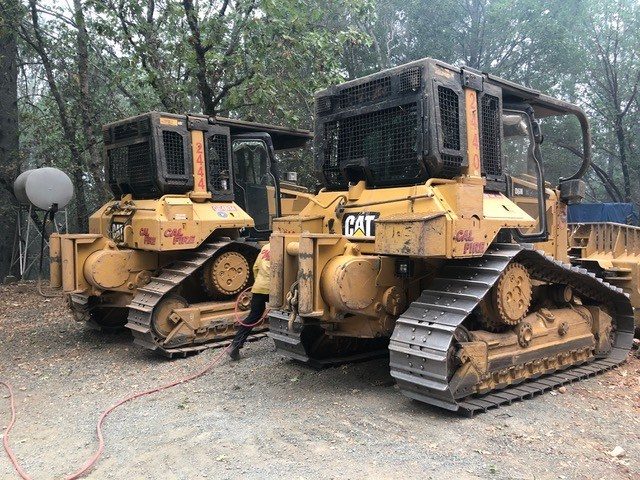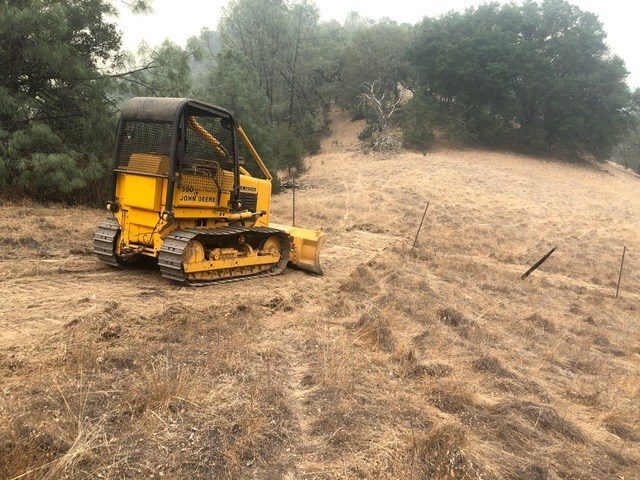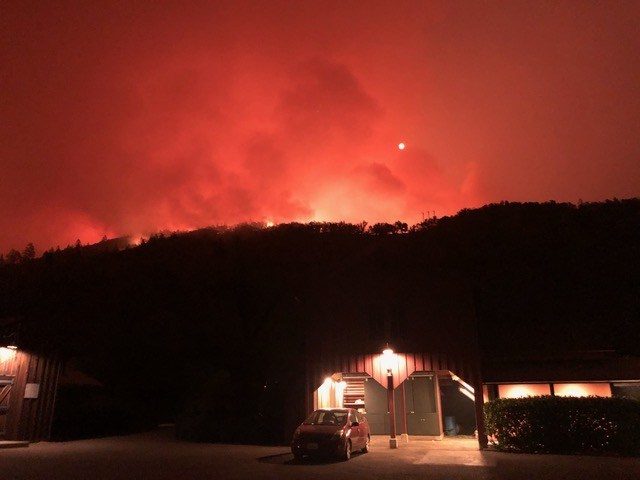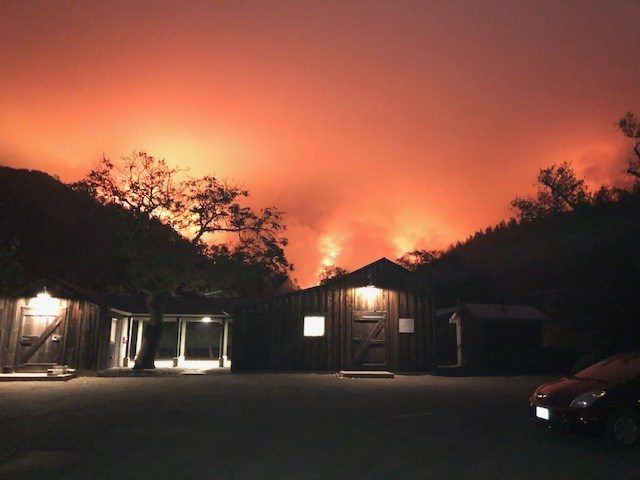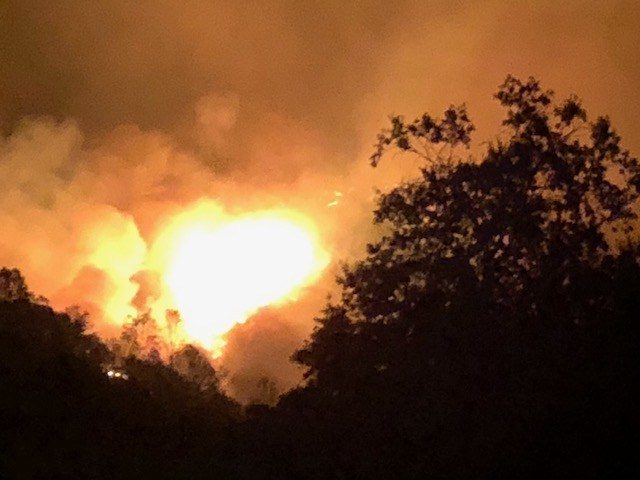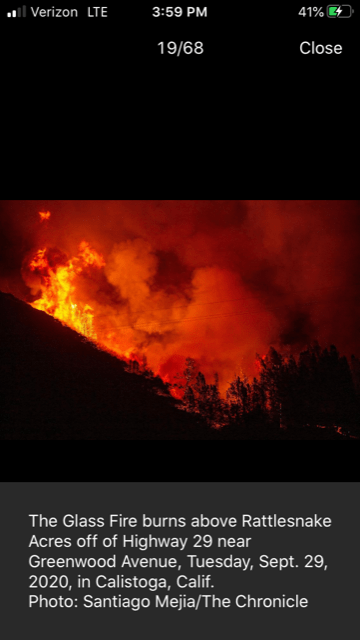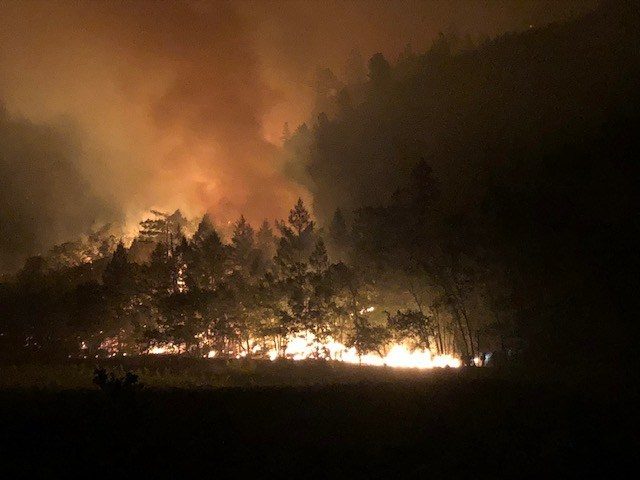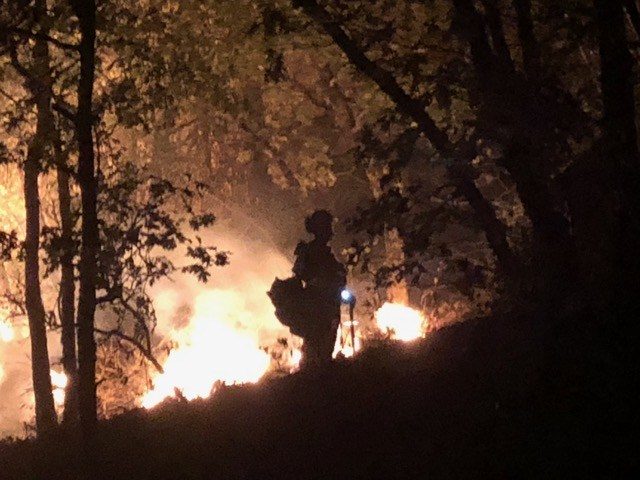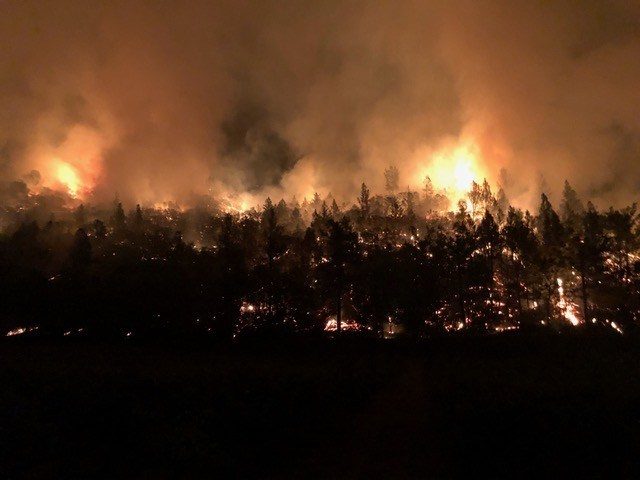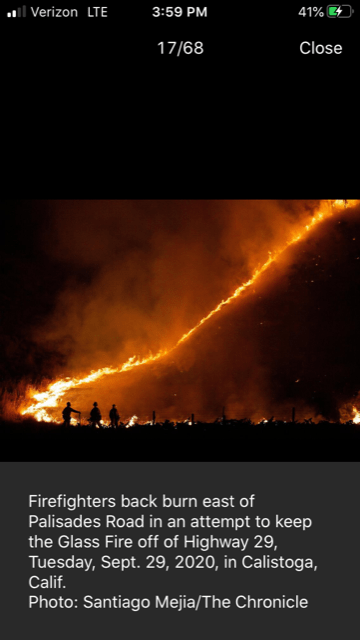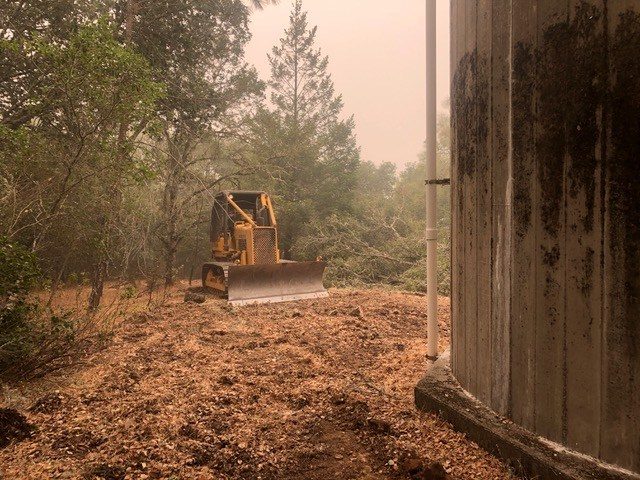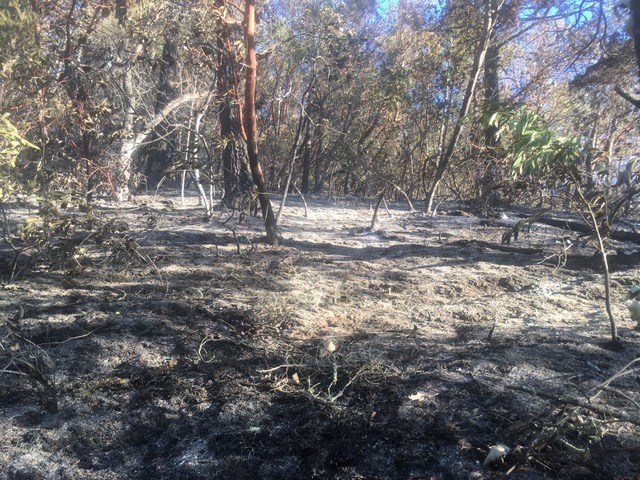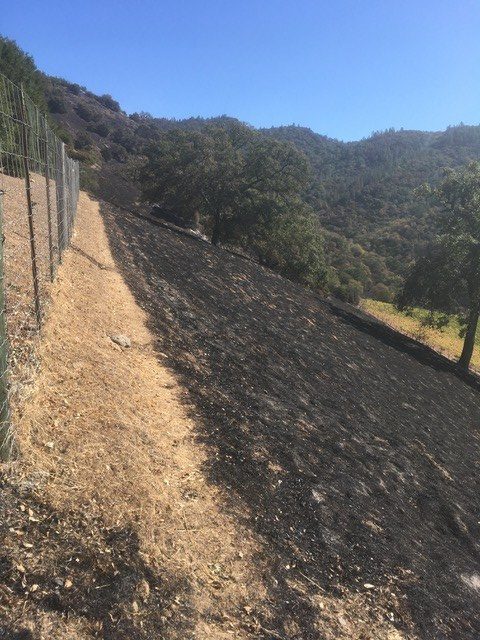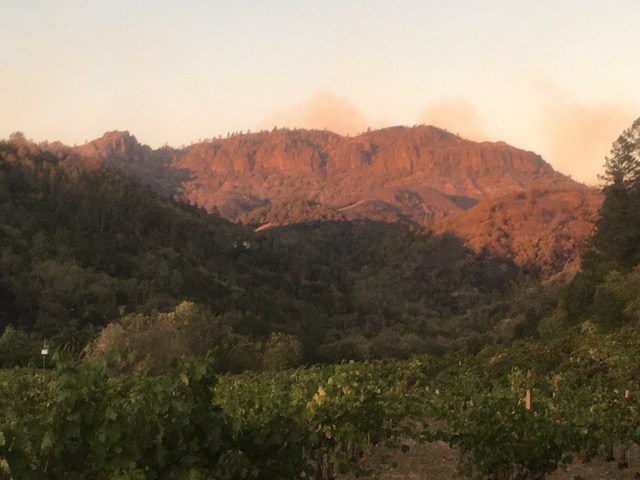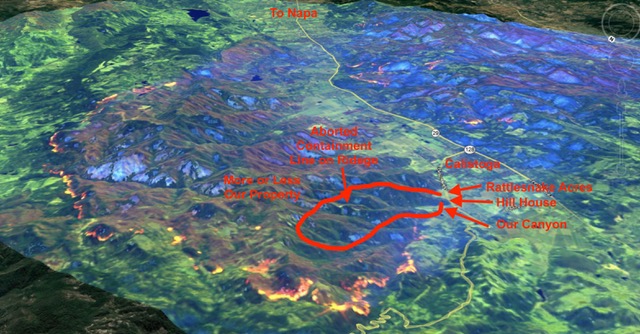NOTE: As Calistoga and the surrounding areas recover from the devastating wildfires that began on September 27, 2020, many heroic and harrowing stories are beginning to emerge. The following is the account of the Glass Fire as written by Steven Rasmussen, of Palisades Vineyard.
I’ve received scores of emails and messages from friends inquiring how we fared with the fire. Here is the complete story to this point. I’ve added and refined a few details to the story that I have learned since sending it out originally. I’m sharing as widely as possible as my way of honoring the firefighters who helped us. You are welcome to share it with others who might know us and be interested.
Today is Saturday, October 3. What an overwhelming week. The Glass Fire, named because it started seven miles south of us on a hill of obsidian used by Native Americans for making arrowheads, has completely changed the ecology of Horns Canyon, our canyon that stretches from our vineyard to the Palisades behind us. We are safe and out of danger. We’ve been choking in smoke for the past several days, however, as our entire canyon and those both north and south smolder. The air quality index was around 600 yesterday, but the smoke has been slowly lifting today. Both a good and bad sign as that means the winds are picking up. The fire is still burning in Jericho Canyon to the northwest, just a mile or so from us. The winds clear the smoke and allow the bombers to drop fire retardant. The winds also fan the flames. As I write, I am tracking the CalFire planes heading from Santa Rosa airport to Jericho Canyon for their drops. One command plane is flying circles above the canyon directing the bombers. Earlier, three helicopters were dropping water from buckets. They’re dipping the water out of nearby irrigation ponds in the neighborhood. Bulldozers have plowed fire breaks up and down and across Jericho Canyon, and according to our friend Dale Bleecher, whose family owns Jericho Canyon Winery, the lines have held so far. He spent the day yesterday with his son Nick and crew discing around the perimeter of his vineyard to turn the earth to form a firebreak. Thursday night, Dale and Nick sought refuge from the flames and danger, along with several other neighbors, here at Palisades Vineyard. This morning he was back in his house asking Felicia for tips on decalcifying his espresso machine—a good sign.
The fire began in the pre-dawn hours on Sunday. Felicia became aware of it with a Nixle alert about 3 am Sunday when the first evacuation order came in for the area around the Calistoga Ranch. Close friends, Rob and Kimberly Reeves have a small house at the entrance to the Ranch. Kimberly had just arrived from their home in Edmonton. Felicia called Kimberly to tell her about the order and she came to our place for the rest of the night. On Sunday, there wasn’t much definitive news of the fire. But from another friend, Chris, who lives just across the Silverado Trail from the Calistoga Ranch, we got word that the night there was a firestorm. Diablo winds, hot winds that come from the Central Valley with gusts up to 80 mph, rushed down the Calistoga Ranch canyon. I learned later from a firefighter who had been on the scene trying to save the Ranch that when the winds started, the fire became a blowtorch. All the firefighters were forced to leave in the inferno that ensued. The Ranch and Rob and Kimberly’s house were incinerated. Chris worked with his son and son’s spouse and fought the embers around their house, saving it. On Monday morning, Chris drove into the Ranch and took a video of the Ranch. This was one shot from his video of the reception area at the Ranch.
While Kimberly and Rob lost their house, their chicken coop and Kimberly’s little art studio were untouched.
By Monday, the fire was clearly heading our way. CalFire was trying to bulldoze their fourth attempt at a containment line, this one up the Oat Hill Mine Road just one ridge south of us. They had lost the three containment lines farther south when embers, carried by the wind, had jumped over the lines. They use massive bulldozers to build the containment lines driven by fearless operators who cut a ridgeline six bulldozer-blades wide (about 60 feet) along the top of a ridge. On Monday afternoon, Chris, the CalFire guy in charge of building these containment lines, came to us to tell us that they had lost the Oat Hill Mine Road line as well and that they needed to cut a new one on the north ridge of our canyon stretching from the Palisades (the mountain wall behind us) all the way down to Palisades Road. For those of you who know our canyon, this is the ridge we hiked on one of our Boxing Day hikes that continues down past our water tanks on the little hill above our pool house. We had cleared the old road to the Palisades along this ridge last year, so I drove Chris in my truck to the rocks just below the Palisades. We got to the top at dusk. Looking south, we could see fire all along the ridge on the Oat Hill Mine Road, and it was slowly creeping down the ridge into Horns Canyon—our canyon. Chris lit glow sticks on the way down the mountain defining a route for the bulldozers. By 8 pm three bulldozers, later joined by a fourth, were rumbling down Palisades Road on their way up our road through Hoisting Works Canyon. By 10 pm we could see glimpses of their headlights high on the ridge under the Palisades. Tuesday morning, I drove my quad up the road to the back and found the bulldozers back down at our neighbor Greg’s house. They were being refueled and serviced and a fresh crew was arriving before they went back up to the ridge to continue their push down to our house. I used this break to head up to the ridge to take a look at their work. They hadn’t done much damage to the road up to the ridge, but when I got to the ridge I was in shock. Our carefully maintained and picturesque road/trail was now a 60-foot wide highway’ flanked by uprooted trees. As I tried to work my way up this “highway” towards the Palisades, I sank to my wheel hubs in dirt the consistency of talcum powder. Where there had been a firm track of decomposed granite, now there was only a hill of dust. This has hit me hard. CalFire vows they’ll “fix the road,” but this wound to the ridge will not heal in my lifetime. The dirt doesn’t grow back.
Soon after I got down to the house, we learned from CalFire that this containment line, like the four before it, had been lost. The bulldozers rumbled back out Palisades Road and headed to Jericho Canyon, just north of us, to begin line number six. There they are resurrecting a line cut during the 2017 Tubbs fire, joining it to a line cut just a month ago during the LNU fire. The goal—blocking the fire from coming back down towards Calistoga during the next Diablo wind event and torching the town. Unlike our line on the ridgeway back in the canyon that we can see from our house, this line meanders among the houses and vineyards along the Old Lawley Toll Road.
By noon on Tuesday, CalFire trucks—pickups with CalFire leaders and engines with four-person crews—started coming down Palisades road and onto our property. During the afternoon we had interactions with dozens of firefighters. We did not evacuate because we know that CalFire would need our help to navigate this large 800-acre property with multiple homes. We have done a lot of work to open fire roads all the way to the Palisades—and CalFire was impressed with the work we have done and thankful for our help. I drove one CalFire leader of these crews around our properties and we inspected the state of the properties and discussed what needed to be done to prepare for the arrival of the fire. I showed the crews how they could get out of the canyon through an exit road we have opened up through our vineyard that would be far safer than the main road to the back. When we got deep in the canyon to the cabin where our neighbor Jeremy lives with his partner and our viticulturist Jennifer lives, the CalFire lead said it was too dangerous to defend this property. Jeremy and Jennifer were not home at the time and I didn’t argue. It is dangerous back there. Trixie who also owns the property and a second cabin back there is vehemently against cutting any trees, so brush grows right up to and over the two cabins.
When this fellow left, another CalFire crew in a big engine showed up. They pruned our olive trees (nicely), a task we have been avoiding for the last five years, and moved a few boards away from our barn and into the vineyard. I drove my dump trailer over to where they were working and they loaded it with the debris. Incredibly nice people. Around 2 pm two CalFire buses carrying California Department of Corrections and Prisons inmates assigned to CalFire fire camps arrived. They were led by Fire Chief Dan Faulkner from the CalFire fire camp in Sonora near Yosemite. Dan was the overall strike team leader for Horns Canyon. The state has long relied on inmate labor for fighting fires. They are trained the same way the state trains CalFire crews. They are paid $1 a day. Until two weeks ago, even though highly skilled and badly needed, they could not get jobs as firefighters when they left prison. Thankfully, Governor Newsom just signed a law so that, if they wish to continue with this work when they are released, they will be able to get work in the field. Before the signing of this legislation, they could not become firefighter due to their felony conviction. CalFire has promised this crew jobs when they get out. Dan has recently hired four of his parolees to work for CalFire. He is rightfully proud of that achievement. Dan in his truck and the inmate buses headed back into the canyon behind us to clear the new small house we bought last year. Around 3, I went back and found they had moved on and were clearing around Jeremy and Trixie’s cabins. I’ve teased Jeremy that they were doing the gardening that Trixie hasn’t allowed him to do for twenty years. I personally thanked each inmate for their work on our behalf. When they were done, the inmate buses headed out to Palisades Road where they slept in their buses.
I had been surprised to find the crews clearing around Trixie and Jeremy’s cabins since CalFire had told me they weren’t going to try to save those. Later I found out that Jeremy had talked to one crew leader doing the work and told him about the rich history of the canyon and that there had been houses there since the mining days in the late 1800s. The fellow had gotten mixed up and thought Jeremy meant that his cabin dated from this era. It is easy to understand how the guy made this mistake as Karl Fisher, a veterinarian from Mill Valley, had built this rustic cabin of square logs in the 1960s so poorly that today it looks 100 years old. Wednesday, when I ran across the crew that worked in the back in Jericho Canyon, the leader told me with pride that they had saved this historic cabin from the 1800s. I didn’t have the heart to tell him otherwise. But I am getting ahead of my story.
After clearing around the cabins and scraping fire breaks, about 4 pm, Chief Faulkner saw Jeremy’s bulldozer parked in our vineyard (in a fire situation, people put vehicles and equipment they want to protect in the middle of vineyards) and asked who owned it. I told him the neighbor with the cabin. He said there were no available bulldozers in the area except the massive ones cutting the fire break and that I should try to use it to create a fire break on the grassy north side of the hill above our vineyard and solar panels. I got a quick lesson from him on constructing fire breaks and went off to find Jeremy. Jeremy and I cut an opening in the vineyard fence near the solar panels and made a two-blade-wide fire break from the road to our water tanks on the north side of the vineyard and down the slope and back through the woods to the northeast corner of our vineyard fence. I chose our route and cut trees and limbs while Jeremy drove the bulldozer.
At 4 or 5, a friend from St. Helena drove up and picked up our best art to take to safety. By six o’clock we were as prepared as we could be. Around that time, five green fire trucks owned by the Governor’s Office of Emergency Services (OES) rolled down Palisades Road and parked across from our gate. The crews in the trucks were from the Sacramento Municipal Fire Department (SFD). OES stations equipment, including these trucks, around the state to be used in emergencies like this one. Fire companies then use the trucks as needed. The lead for this team, Battalion Chief Greg Powell and the strike team leader for this group, told me that there were few resources available, CalFire was maxed out, and that these five trucks would protect us. They deployed around us—one to our canyon house in the back, one to our hill house on the ridge, one to our neighbor Dean Enderlin’s house (RattleSnake Acres) in the canyon south of us. I think the other two deployed to neighboring properties, but I lost track of them. None deployed to our main house complex in the vineyard as they felt we were safe where we were, protected by the vineyard. I didn’t yet realize it, but Tuesday night was going to be our big night.
By dusk Felicia, Jeremy, and I could see big smoke plumes rising over the ridge to the south of the house. As evening set in, these plumes glowed orange and we could also see flames far in the back of our canyon. As it turned dark, we saw smoke start to rise closer in approximately the area where Jeremy’s cabin and our canyon house are located. We were worried about those. At dark, suddenly, rockets shot up from the area around the canyon house and cabins and landed on the large hill in the center of our canyon just behind the spot where the north and south forks of Horns Creek join. We could see flames shoot up as the incendiary flares exploded on the hill. Within minutes, the hill was a massive ball of fire. The air was cool and damp, the sky above us was clear and we could see the stars, the breeze carried the smoke slowly away from us towards the Palisades in the rear of the canyon. It wasn’t clear what was happening, but we knew the fire was coming. Over the next half hour, it crept closer and closer. Soon after we saw flames rising above the ridge next to us coming from a different direction.
Below you see the fire coming over the ridge just south of the house. We are standing in our parking area in front of our house.
In the photo below you can see two clear spots where incendiary rockets landed on the back hill.
Minutes later these spots had merged to form a fireball as dead pines ignited.
Suddenly, Felicia noticed something we couldn’t understand, a light (it turned out to be a helmet headlamp) was moving just below the south ridge where on our hill house ridge trail. It moved from the front of the canyon towards the back and then reversed direction. As it moved now, it left a small dot of fire every three feet or so. Someone was torching the ridge. By the time that person (more likely persons) on the trail approached the area of the hill house, the entire ridgeline was aflame.
I jumped on the ATV and rode up to the hill house to see what was happening. As I rode up the driveway I looked over the ridge and into the canyon to the south behind Dean’s Rattlesnake Acres vineyard and saw that there was a fire truck in front of his house, a fire line along the back of his vineyard, and that the entire canyon behind him, including the south slope of our hill house property, was ablaze. The fire had climbed the slope almost to the top of our ridge on that side. The smoke and flame from this fire was what we could see from our house in the vineyard.
The fire in the picture below from the SF Chronicle is on our hill house property, climbing the ridge toward the spot where I looked down!
Immediately after I got to the hill house, Chief Powell from SFD came down the little ridge road from the back and approached the deer fence gate where our loop trail to the top of the ridge starts and ends. He was driving the Kawasaki Mule that we keep near the gate. Another firefighter was in the back, waving a wand from side to side, torching both sides of the road as they drove down the hill. In sync with the Mule, two hikers, one approaching on each side of the ridge, emerged from both legs of our trail trailing flames from their own wands. The one on the north side was the fellow lighting the flames that we had seen. As Chief Powell parked the Mule back in its parking place he was relaxed and confident. He joked about having commandeered it and how well it ran for its age. I told him I was worried. He replied with a sentiment I would hear several times from the SFD firefighters that night, “Don’t worry. This is our fire. This is our night. We control this fire.” What we had been watching for the last couple of hours started to make sense to me. This was a controlled burn. And these firefighters were manipulating fire as if they were directing a fire “ballet.” They were turning Horns Canyon and the adjoining canyons into an enormous fire break to protect Calistoga in case the winds shifted. At the same time, they were saving our buildings and vineyard. I drove back down the hill to our main house to report what I had seen to Felicia.
The fire ballet, orchestrated by the CalFire and the SFD strike teams, continued to unfold. Along the road to the house and cabins in the rear that stretches the length of our vineyard, a group of firefighters were walking, igniting the side of the road against the canyon wall as they walked. As they walked, every three feet or so they ignited drops of a kerosene-gas mix.
They actually lit two lines of fire—one a zig-zag “line” with diagonal stretches going up and down the slope followed by another straight line at the edge of the road. These lines formed a series of connected right triangles with the hypotenuses at the edge of the road. As they worked their way along the road, Felicia, Jeremy and I fell in below them on our side of the vineyard fence, walking along with them, only 15 feet below. This crew, from the truck stationed in the back at our canyon house, were relaxed, talking and joking as they walked. We took pictures and videos.
We were surprised not a single ember floated into the air in our direction. We learned later from the firefighters that to control the fire they light two lines of fire when they can, not one. The first line is the outer one in the direction they want the fire to travel, away from whatever they want to protect. As this fire builds it draws in oxygen and forms an updraft. The second line, “drawn” where they want to the fire to stop, is pulled toward the first line. This allows them to control both the position and direction of their fire lines. Along the road, the diagonal cuts up the slope were the lines that drew the fire along the road up and away from our vineyard. This same technique had been used to ring the house and cabins in the back. Essentially, two concentric circles of fire around the buildings, with the outer circle lit first.
The photo below shows the fire along the road. At left you can see one of the diagonal lines lit to draw the fire up the hill. Once the fire is headed that way, it continues to move up the hill on its own.
Here is one of the firefighters walking on the road above us after igniting the edge of the road.
As the crew got to the end of our road near the power lines that went up the hill, one of the crew hiked up the slope laying down a diagonal line slanting away from the power lines. This was the “stop” line. We walked back to the house and looked across at the canyon wall. By then the entire canyon wall was ablaze. The fire had climbed the hill to meet the ridgeline fire the other crew had ignited. Once that ridge was ablaze, both crews continued igniting lines below the 200-foot defensible area we had cleared around the hill house all the way down and around the property along Highway 29. When they were done, except for the narrow corridor below the power lines that lead to the hill house, the hill house was completely ringed by fire. We went to bed around 1 am, feeling completely safe in the hands of the fire crews. By then, the flames in some areas were dying down. In many areas, burning Douglass fir trees were sending flames a hundred feet into the air. No embers, nothing out of the control of the fire crews.
The photo below, taken at about the same time, is copied from the SF Chronicle. It shows a similar “stop” line on the south side of our property. Chief Powell’s SFD team used several of these lines up the canyon above Rattlesnake Acres to segment the will and direct the fire back, away from our house at the top and away from our vineyard on the other side.
The fire passed through Horns Canyon on the perfect night for a controlled burn. In fact, the only night of the week this would have been possible. We were lucky. And the CalFire SFD fire crews were awesome, brilliant, and ready for a win. We got up early Wednesday morning and I headed out on the ATV to survey the area around the buildings and vineyard. The woods were smoldering and some tree trunks were still burning, but there was not a single place where the fire had breached the fire lines. The control was perfect. Damage to our developed property: three or four fenceposts on our deer fences.
Wednesday a CalFire crew came by to deal with one loose end. The fire had crept down the canyon wall on the north coming from the back of the canyon to the front near our fire tanks, and down the slope to our fire line, but there was no clear line to stop the fire on this side. CalFire did not think the road to our fire tanks would hold the fire back. They knew the fire would creep slowly on this side of the canyon and this detail could wait until daylight. They were right. And I was amazed that they were tracking these details and came back to deal with this. Jeremy cranked up the bulldozer and we tightened up our fire break and scraped the road down the backside of the ridge into the next canyon. We added another break back into our vineyard completing a complete circle around our solar panels and then along our vineyard avenues inside our fence to Palisades Road. Then the crew helped me cut down oaks near our fire tanks and Jeremy put a ring around the tanks with his dozer. The CalFire crew “walked” the fire down the road. Then they headed up to our neighbor Greg’s house and walked the fire completely around Greg’s house by igniting fire lines there.
Wednesday night, Felicia and I took turns waking and checking the perimeters of our no-burn areas. Just as Jeremy was going to sleep in our pool house, I found a large oak tree with a trunk burning on the edge of our fire break. It was going to fall across our fire break and then the fire would have traveled up the tree and ignited the side inside our vineyard area. I got Jeremy and we doused the trunk, cut down the burning tree, and put the burning wood outside our fire line and the unburned limbs inside. We went to bed and I slept soundly until it was my turn to patrol around 3 am.
Since the fire passed through, crews from all over the state show up every couple of hours to check on the fire lines and to put out hotspots. We’ve doused a few areas ourselves, but mostly we direct them to problem areas we see. By now, four days later, there aren’t very many places where the fire is still smoldering. When there is a flare-up, a fire truck shows up to douse it. Tonight, it’s a crew from Contra Costa County patrolling our properties.
Even though we understood a lot about the strategy of CalFire and SFD on the night of the blaze, the full story didn’t come out until days later when I had a chance to look back with Chiefs Powell and Faulkner—in relaxed conversation. Several days after the fire in our canyon, while I was checking on neighbors and picking up gas, I ran into Chief Powell and the crew the hill house engine at the gate to Jericho Canyon Winery. They described their strategy in detail to me. Among the details, I learned was that after they had intentionally set the canyon behind Rattlesnake Acres on fire, they felt the fire was climbing towards our ridge too fast and wanted to slow it down so it didn’t rush back down our side of the ridge towards our house and vineyard. By lighting the ridge, and sending fire up on both sides, they effectively stopped this front of the fire. I also was told how impressed they were with the work we had done clearing trees and brush around our houses and that they carefully considered that in where to start the burns. If you go to the hill house today, you wouldn’t know there had been a fire unless you peered down the hill. We cut such a big defensible zone over the last year that there was no need to burn close to the house.
Chief Powell put multiple lines of fire like the one in the photo up the canyon wall to burn the canyon wall in an orderly fashion—back to front.
Later, I talked to Chief Faulkner. It turns out I had warned him that winds often blow up our canyon late in the afternoon. Around six, he went up a zig-zag dirt track Jeremy had bulldozed many years ago up the north canyon and waited for the wind. It never came. From there, with a view up and down the canyon, he orchestrated the burn, including coordinating the work of Chief Powell’s teams. He said he could see eight different watersheds from there and had to develop a strategy to account for this complex terrain. He set the north slope on fire first, burning his way down the canyon trail. Then he climbed the south slope behind Jeremy’s cabin to light that side. The team at our small house back in the canyon felt safe enough where they were to stay as he lit the behind them. Then he called for Chief Powell’s crew to ignite the canyon behind Dean’s place to send the fire back, away from our vineyard.
I took the photo below this morning as the smoke began to clear.
The woods generally look like the picture below. Where there was poison oak, there is none now. We’ll be able to explore easily.
This gives you an idea of the precision of the SFD crew creating their fire lines! This particular shot is taken south of the hill house.
Since the smoke has cleared, we feel better than we expected by what we see. Fire is a natural part of the growth cycle in the forest. The forest floor is clean and the burned vegetation will provide nutrients to the trees that survive. Most of the large trees are only singed and will come back. The weaker ones will make room for new growth. We grieve for all the animals that died and will do what we can to help those that survived—except for the beetles that kill our pines. They are gone, thankfully, for many years.
Just part of the cycle. It will be exciting to witness the rebirth of our canyon. We’ll have to adjust to a new palette in our view—more brown mixed in with the green. The black on the hillsides will give way to grass before the new year. The firefighters who witness this every season assure us that the forest will heal and thrive and be better for what has happened. This is just what renewal looks like. The happiest things in the forest today are the knobcone pines that grow on the back ridge above our canyon house. They live for about 60 years, but their cones only open and drop seeds when the cones burn. The last fire swept through our canyon in 1964–56 years ago. Tonight, the knobcones are popping Champagne.
By sunset tonight, it seemed calm was restored to our canyon.
Even as our own canyon returns to calm, the fire battle rages very near. We were lucky—way luckier than most in the valley touched by the fire. The fire passed here on the perfect night–temperature, humidity, wind—for a controlled burn. It was “our night.” That has happened in few, or maybe no, other spots in the 60,000 acres now consumed by the Glass Fire. While every bit of our property—and the thousands of adjoining acres–burned, Felicia and I lost not a single building or piece of equipment. When I talked to Chief Powell yesterday—the same fellow that commandeered the Mule—he said to me, “Sorry about those fenceposts.” (We lost three or four fenceposts as the fire burned to the fences.) I replied, “Don’t worry about it, you only burned the bottom six inches.” He smiled.
I need to close by thanking the heroic firefighters who were here for us on more levels than you can imagine. While much of the heavy lifting was done in our canyon by CalFire and the Sacramento Municipal Fire Department, at least 20 trucks from other jurisdictions, from counties all over the state, together with inmate firefighters from who knows where have come through to help us. Every one offered not only assistance with the fire, but assistance with our spirit. We’ve come to appreciate that these men and women are not only brave and dedicated, they are also brilliant at what they do. The controlled burn on our property was enormous in scale and executed to perfection. I still can’t believe what I witnessed. I want to give special thanks to Chief Powell, SFD Strike Team Assistant Brian Vidosh and Shawn Wolf, Captain the OES Type 3 Engine and their fellow SFD firefighters. They saved our hill house—and probably our home and vineyard as well.
Our local fire committee started working with Josh Randol, Battalion Chief for CalFire in St. Helena, a few months ago and I have been the point of contact with the chief. Even though I knew he was in the thick of fire fighting, I called him Wednesday morning to thank him for the brilliant work of his team. Secure in the hands of CalFire and SFD Tuesday night, we were calm and relaxed in a way that made no rational sense. Many of our friends ask if we were terrified. We were not; we felt secure. Wednesday morning talking to Captain Randol, the emotion hit me. I broke down. He understood. Every firefighter I’ve met—dozens—have the same attitude. They understand what we went through. When I’ve thanked most of the firefighters for their help over the last few days, I’ve received, in slightly different words, a version of the response that Captain Wolf gave me, “You are welcome. This is what we do.” Pretty humbling.
One more crazy photo, this one sent by a friend and taken from a satellite around noon on Friday, after the fire passed us. Enlarge it to read the captions.
